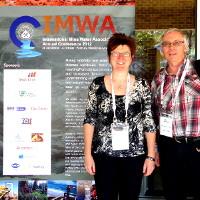Posted 8 October 2012

IMWA congress attendees Dr Wendy Timms (UNSW and NCGRT) and Dr Jerzy Jankowski (Sydney Catchment Authority).
CWI was represented at the recent International Mine Water Congress in Bunbury, Western Australia. The congress, attended by close to 300 participants, included fieldtrips looking at pit lake management across the Collie River catchment, a historic and active coal mining district.
During the congress, Wendy Timms presented an introductory framework of leading practices for assessing potential impacts of underground mining and coal seam gas extraction. The ideas sprang from work that co-author David Laurence did for the LPSD program. The Leading Practice Sustainable Development Program for the Mining Industry (LPSD) is a program that promotes sustainable development and industry self-regulation through proactive adoption of leading practice principles. A series of 15 guidelines books are available online.
Complementing the water handbook, this congress paper provides more specific steps for leading practices focused on vertical seepage of water. The proposed risk based assessed framework for vertical seepage includes multidisciplinary methods to indicate how effectively natural barriers are limiting seepage. Up to three levels of assessment are available for projects and sites with a higher risk of impacts, or as a proactive strategy.
Evidence that low permeability strata form reliable barriers to flow between shallow aquifers and coal seams is often lacking because of many challenges. However, new tools can help beat costs and lengthy testing times. Tools like isotope and biomarker tracing, and geotechnical centrifuge testing of drill core means can greatly improve model predictions of groundwater flow over decades and hundreds of years.
Leading resource companies are already starting to utilise some of these methods, and Wendy's presentation generated several positive responses.
Acknowledgement: This work was funded by the Australian Research Council and National Water Commission through the National Centre for Groundwater Research and Training, program 1B. The UNSW School of Mining Engineering contributed funds for Wendy to participate in the IMWA congress.
Links:

Professor Andy Baker features in American Water Resources Association ‘Water Resources Impact’, September 2020 edition.

The Connected Waters Initiative (CWI) is pleased to welcome Taylor Coyne to its network as a postgraduate researcher. If you’re engaged in research at a postgraduate level, and you’re interested in joining the CWI network, get in touch! The CWI network includes multidisciplinary researchers across the Schools of Engineering, Sciences, Humanities and Languages and Law.

The Grand Challenge on Rapid Urbanisation will establish Think Deep Australia, led by Dr Marilu Melo Zurita, to explore how we can use our urban underground spaces for community benefit.

On the 21 August 2020, CWI researchers made a submission to the National Water Reform Inquiry, identifying priority areas and making a number of recommendations as to how to achieve a sustainable groundwater future for Australia.

Results published from a research project between the Land Development Department (LDD) Thailand and UNSW has demonstrated how 2-dimensional mapping can be used to understand soil salinity adjacent to a earthen canal in north east Thailand (Khongnawang et al. 2020).